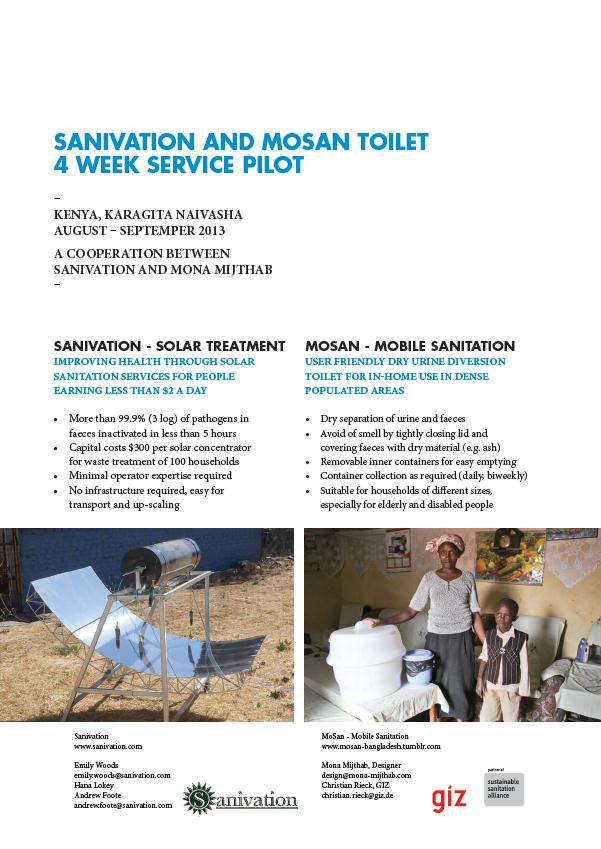Sanivation and MoSan Toilet - 4 week Service Pilot in Karagita Naivasha, Kenya
Mijthab M., Woods E., Lokey H., Foote A., Rieck. C (2013)

Published in: 2013
Publisher:
GIZ and Sanivation
Author:
Mijthab M., Woods E., Lokey H., Foote A., Rieck. C
Uploaded by:
SuSanA secretariat
Partner profile:
Deutsche Gesellschaft für Internationale Zusammenarbeit (GIZ) GmbH
13655 Views
217 Downloads
Location of library entry
Content - Summary
Having worked in Naivasha since November, 2012 the Sanivation team became aware that in-home toilets could provide an alternative solution to the standard pit latrines in the area. Sanitation practices in the area, while not as dire as some areas of Kenya, include the use of expensive and often unclean outdoor pit latrines, which often leave residence (especially women and the disabled) Feeling unsafe and uncomfortable. To address these expressed concerns, Sanivation, Hana Lokey and Emily Woods collaborated with Mona Mijthab, the designer or the MoSan mobile toilet, to conduct a 4-week pilot test of the toilet and the sanitation service in peri-urban villages of Mirera and Karagita outside Naivasha, Kenya. Within this report, “the team” will be used for some combination of Hana, Emily and Mona.
The goal of Mona is to further develop the design and the usability of the MoSan toilet and improve it’s performance within the service. Therefore user feedback was collected throughout the pilot phase.
Overall, the goal of the pilot was to evaluate the scalability of the sanitation service. Specifically the team wanted to explore and improve:
1. User friendliness and acceptance of a household toilet
2. Efficiency of the sanitation service, including house-to-house collection and solar treatment
3. An evaluation tool for in-home toilets*
Bibliographic information
Mijthab M., Woods E., Lokey H., Foote A., Rieck. C (2013). Sanivation and MoSan Toilet - 4 week Service Pilot in Karagita Naivasha, Kenya. GIZ and Sanivation
Filter tags
English Faeces or faecal sludge Sub-Saharan Africa Urban (entire city) Urine Urine diversion dehydration toilets (UDDTs)














